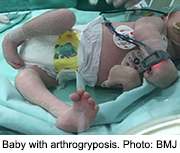Cause isn’t clear, but brain scans hint that problem comes from nerves, not joints
WEDNESDAY, Aug. 10, 2016 (HealthDay News) — The Zika virus may be the cause of joint deformities in the arms and legs of newborns (arthrogryposis), according to a report published online Aug. 9 in The BMJ.
Vanessa van der Linden, M.D., of the Association for Assistance of Disabled Children in Recife, Brazil, and colleagues studied brain and joint images of seven children with arthrogryposis in Brazil. All the children had been diagnosed with a congenital infection, most likely caused by the Zika virus. The children were also tested to rule out five other main infectious causes of microcephaly — toxoplasmosis, cytomegalovirus, rubella, syphilis, and HIV. None of the children had these infections.
Brain scans showed that all of the children had signs of brain calcification. One theory is that Zika virus kills brain cells and forms scar-like lesions in the brain on which calcium is deposited, the researchers said. The children had scans of their joints and surrounding tissues. No evidence of joint abnormalities was found, van der Linden said. Based on these findings, “congenital Zika syndrome should be added to the diagnosis of congenital infections and arthrogryposis,” she told HealthDay.
The researchers don’t know exactly how Zika might cause these deformities. They suspect that problems in nerve cells that control movement caused the infants to stay in fixed positions in the womb, which led to the deformities.
Full Text
Copyright © 2016 HealthDay. All rights reserved.








